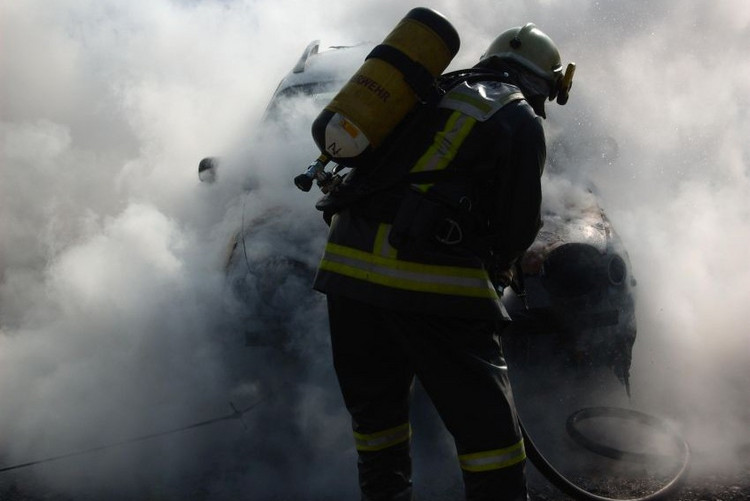Pressemitteilung
German environmental protection NGO warns against fire hazards from the new refrigerant 1234yf for Mobile Air Conditioning
: The environmental and consumer protection NGO ”Deutsche Umwelthilfe e.V.“ (DUH) calls on all U.S. car manufacturers to follow the lead of the German automotive industry on its way towards a green automotive technology. In October 2008, the manufacturers Mercedes, BMW and Volkswagen/Porsche decided against the chemical refrigerant 1234yf in future Mobile Air Conditioning. The German car manufacturers consider the risks emanating from this chemical to be too high for car passengers and first aiders in case of an accident. They thereby support Deutsche Umwelthilfe e.V. in its call for an immediate pullout from chemical refrigerants cooling technology.
The environmental protection NGO urges all U.S. manufacturers to use the automotive sector’s current crisis set the course towards a sustainable and future-proof economy. “Only climate friendly, energy-efficient and low consumption cars will have a future in the U.S. and succeed in an international competition,” said Jürgen Resch, CEO of Deutsche Umwelthilfe, in Sacramento, California, today. “The crisis in the automobile industry must be seen as a unique opportunity to bring about a change. The manufacture of climate friendly passenger cars is possible today. Vehicle air conditioning systems of all future car models worldwide must be equipped with natural refrigerants that lead to the least environmental burden, carry no risks for car occupants, and will comply with any future legislation.”
The background to the present international discussions about the next generation of Mobile Air Conditioning is the new chemical refrigerant 1234yf. This new product of U.S. chemical groups Honeywell and DuPont is meant to replace the currently used refrigerant R134a from 2011 on. In all countries of the European Union, R134a will be banned in new passenger cars starting from that year. The reason is the refrigerant’s high Global Warming Potential (GWP) of 1.400, meaning that one gram of the chemical will harm the climate 1.400 times more than one gram of carbon dioxide. The EU Directive 2006/40/EG, prescribes a significantly less GWP for all refrigerants used in cars after 2011. The only environmentally and climate friendly alternative, that has also been thoroughly tested and is ready for serial production, is the natural refrigerant carbon dioxide – also referred to R744. CO2 has a GWP of only 1 and is available worldwide at low costs. Therefore, Deutsche Umwelthilfe e.V. calls upon the automotive industry to only use CO2 as a refrigerant in new passenger cars.
With a view to the U.S. American market, Resch demands a clear signal for climate protection. Otherwise the U.S. car industry would run the risk to see another credibility debacle: “The EU Directive will be effective already from 2011 on, technical decisions about future car models must be made as we speak.” Over the last few weeks, stricken U.S. corporate group GM has made headlines with its bid for credits in the range of 12 billion US$ - to develop environmentally friendly vehicles. At the same time, GM withdrew major orders for CO2 components used in automotive air conditioners, and now seems to have opted for the chemical 1234yf, clearly due to cost reasons. “It seems that GM’s promise to only manufacture green cars in the future was only meant to convince Washington to fork out billions of financial help.” Resch said.
Concerned about the environment and the health of drivers and rescue personnel, DUH and Dr. Axel Friedrich, Transport expert and former head of the division “Transport and Noise” in the German Federal Environmental Agency (UBA), tested the new chemical refrigerant 1234yf. The results painted a bleak picture: 1234yf is flammable and releases highly toxic gases while burning. At about 600°C (1112 °F) and simulating an accident where the refrigerant hose is ripped off, the refrigerant caught fire in the motor manifold area and set the vehicle on fire. Besides this the burning refrigerant released highly toxic hydrofluoric acid in high concentrations.
In an official data fact sheet for 1234yf, Honeywell admits that the chemical is “extremely flammable” in the gas phase, requiring special safety precautions in the case of burning, such as protective clothing and gas masks at all time. Moreover, the data sheet also contains the clear warning “Evacuate area”. The warning to clear the space around a burning car with 1234yf is appropriate as the same Honeywell safety data sheet confirms diverse “hazardous decomposition products”, including hydrogen fluoride. This, in contact with water, decomposes into hydrofluoric acid, a highly toxic acid already at low concentrations.
„This means a regression for the environment and climate protection. The advantage, in view of the industry, is that this chemical can be used in current air conditioning systems without any additional investment to rebuild the device. We are appalled at the amount of problems related to 1234yf. A responsible car manufacturer should not equip its new vehicles with dangerous substances, but rather opt for a natural refrigerant.” said Dr. Axel Friedrich, Transport expert from Germany.
Another problem adds fuel to the fire, according to Deutsche Umwelthilfe. The patents for the currently used refrigerant R134a will expire soon. As a result, it can be manufactured at a small fraction of the costs of the new patented chemical cocktail 1234yf. Especially in Asia, it is therefore highly likely that the climate killer R134a will be used as a refill for 1234yf worldwide, even if the first charge was made with 1234yf, Dr. Axel Friedrich fears. Climate damaging greenhouse gases would continue to harm the atmosphere without need. The natural refrigerant CO2 is cost-efficient and would require a completely new technology which would impede a refill with R134a. This, in turn, would prevent unneeded greenhouse gas emissions on a large scale.
A video documentary showing the performed tests with 1234yf is available at:
www.duh.de/aircon_movie.html
For more information please contact:
- Jürgen Resch, CEO Deutsche Umwelthilfe e.V.: resch@duh.de
- Dr. Axel Friedrich, Transport expert: axel.friedrich.berlin@gmail.com
- Eva Lauer, Projet leader, Deutsche Umwelthilfe e.V.: lauer@duh.de
About Hydrofluoric acid:
(taken from Wikipedia)
Hydrofluoric acid is extremely corrosive and a contact poison. It should be handled with extreme care, beyond that accorded to other mineral acids, in part because of its low dissociation constant, which allows HF to penetrate tissue more quickly. Symptoms of exposure to hydrofluoric acid may not be immediately evident. HF interferes with nerve function and burns may not initially be painful. Accidental exposures can go unnoticed, delaying treatment and increasing the extent and seriousness of the injury. HF is known to etch bone, and since it penetrates the skin it can weaken bones without destroying the skin. More seriously, it can absorb into blood through skin and react with blood calcium, causing cardiac arrest.
In the body, hydrofluoric acid reacts with the ubiquitous biologically important ions Ca2+ and Mg2+. In some cases, exposures can lead to hypocalcemia. Amputation may be required as a result from HF chemical burns.


